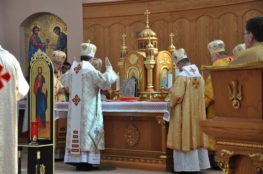Web-logging about complex phenomena is always a fraught enterprise, particularly when no single blog post can hope to capture the density of religious and political life in Europe during the last century. Yesterday’s entry, “Comments on the Cross and the Sword in Ukraine,” may have left some readers with the (false) impression that the intersection of the Ukrainian Greek Catholic Church (UGCC) with national political life amounted to little more than the subservience of the UGCC to bald nationalistic interests. Nothing, I would argue, could be further from the truth. For while it is true that some segments of the UGCC became too involved in the affairs of Ukrainian nationalism at the expense of its God-ordained vocation, the sticky truth of the matter is that the UGCC, since the 18th Century at least, found itself placed in a complicated role of both forging a political living space for the faithful it served and putting itself in the service of saving souls.
Two previous posts, “Another Note on Latinizations” and “A Lesson from Ukrainian Catholic Action,” touched lightly on some of these matters, though a more thoroughgoing analysis of the unique situation of Ukrainian nation-building and the role of the Church in it is still to come. With what little ground has been tread already on Opus Publicum, it is possible to say that the push for a fully independent Ukrainian state in the early 20th C., though occasionally compromised by nationalist ambitions and other ideological baggage, is almost impossible to separate from the larger ambition of the UGCC to maintain an authentically Christian polity which resisted the twin temptations of the times: capitalism and communism. Moreover, the development of a particularly Ukrainian Christian nationalism was not pursued in the vain hope of granting a false messianic status to Ukraine, but rather to ensure that the emergence of a fully independent Ukraine did not go hand-in-hand with accepting either the liberal or radical Left premise that religion should be, at best, a private affair or, at worst, a disease from which the populace at large should be cured of.
Crossover between religious identity and nationalistic ambitions was inevitable. As such, it is prudent for Catholics to be cautious about adopting what I will loosely call “the Ukrainian model” for implementation in today’s liberal-dominated milieu. In the United States especially there is nothing akin to a “national identity” that can be separated from liberal ideology. America is a plural land, though acknowledging that fact does not mean accepting the questionable ethos of “pluralism.” The Ukrainian experience of the 1920s and 30s was bound up with the existence of a concrete ecclesial body that was willing to agitate for a social order in the light of timeless Christian principles, including a prudential principle of toleration for non-Catholic Christians such as the Russian Orthodox. (Admittedly, and regretfully, this principle was not always adhered to despite the noble efforts of Metropolitan Archbishop St. Andrey Sheptytsky to uphold it during the tumultuous decades of his reign.)
What the Ukrainian experience does bequeath the present generation is both a firm reminder that the nation never comes before God and that the Church is a public, not private, institution which holds its position by divine right. The individual shortcomings of bishops, priests, and laity should not obscure the timeless truth that Christ reigns over both His Church and the world’s states. That fact is the essence of the Catholic doctrine on the Social Kingship of Christ and it was one not lost on the members of the UGCC—clerical and lay—who eventually gave their lives in its service.



